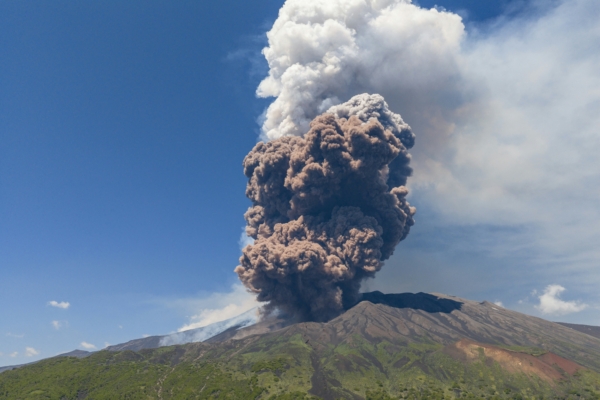On Monday, June 2nd, Mount Etna, the volcano on the island of Sicily, Italy, suddenly erupted violently, spewing out a large amount of volcanic ash, hot gases, and rock fragments, instantly forming a towering volcanic plume reaching several kilometers in height. Accompanied by enormous roaring noises, many tourists panicked and fled the scene.
The National Institute of Geophysics and Volcanology (INGV) in Italy reported that at around 11:24 am local time on Monday, Mount Etna’s crater emitted a loud bang, followed by a massive and dense column of volcanic ash shooting straight up into the sky, quickly reaching a height of about 6.5 kilometers.
The spokesperson for the institute stated that around 1 pm, Mount Etna began spewing out molten lava, showing signs of weakening by evening. This eruption even caused a “partial collapse” on the north slope of the volcano’s southeast crater.
The institute classified this volcanic activity as a “pyroclastic flow eruption,” accompanied by significantly intensified volcanic tremors, forming a volcanic cloud column composed of high-temperature gases, lava particles, volcanic ash, and rocks of various sizes, rushing down the volcano slopes at extremely high speeds, posing a high level of danger.
This sudden eruption was not only visually stunning but also sent out enormous explosive sounds that shook the surrounding areas. Residents in Taormina, located 50 kilometers away, and Catania, located 40 kilometers away, clearly heard the explosion and felt notable tremors.
Due to the volcano erupting without warning, a large number of tourists who were touring the mountain suddenly found themselves in a state of panic. Videos and images circulating on social media showed tourists fleeing frantically downhill along rocky paths as the massive volcano ash cloud appeared in the sky.
However, the National Institute of Geophysics and Volcanology of Italy stated that all tourists and hikers present at that time had been safely evacuated. They emphasized that despite the immense power of the pyroclastic flow, this eruption “did not pose an actual threat to local residents,” and the area near the volcano crater was quickly designated as a danger zone, prohibiting tourists from entering.
Renato Schifani, the President of the Sicilian Regional Government, promptly informed the public that the government’s civil protection department was closely monitoring the volcano activity. Currently, the lava flow remains within safe areas and has not posed further dangers to surrounding regions.
Meanwhile, the Sicilian Civil Protection Department has issued a volcanic flight safety warning, requiring all flights to steer clear of the erupting area. However, due to the wind direction, a significant amount of volcanic ash has not yet fallen near nearby airports, and both Catania and Palermo airports remain open.
Mount Etna has multiple craters and is Europe’s most active volcano, as well as one of the most frequently erupting stratovolcanoes globally. In recent years, the volcano has been consistently active, attracting around 1.5 million tourists annually to visit. However, the sudden and intense nature of this eruption caught both tourists and residents off guard.

